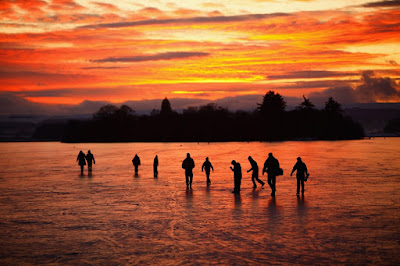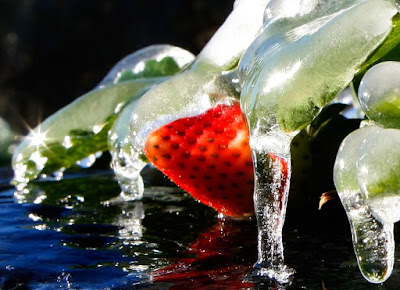 On January 4, 2010, people out on the frozen Lake of Menteith in Scotland are enjoying a nice walk (Credit: Jeff J Mitchell/Getty Images). Where I live, the temperature never gets cold enough to freeze the lake to the point where we can walk or skate over it. While I'm not a big fan of cold temperatures, I do enjoy outdoor skating and it would be nice to experience skating on the lake once in my lifetime. I guess I could always take a flight to Scotland and skate there :)
On January 4, 2010, people out on the frozen Lake of Menteith in Scotland are enjoying a nice walk (Credit: Jeff J Mitchell/Getty Images). Where I live, the temperature never gets cold enough to freeze the lake to the point where we can walk or skate over it. While I'm not a big fan of cold temperatures, I do enjoy outdoor skating and it would be nice to experience skating on the lake once in my lifetime. I guess I could always take a flight to Scotland and skate there :)This picture is a study in contrasts, and, along with others found in Fire and Ice - The Big Picture, has inspired me today. Take a look at the rest of the images, which are absolutely breathtaking. One day, when I get a really nice digital SLR camera, I'll hopefully be able to take such nice photos. Although I suppose it doesn't matter what camera you have if you're not willing to take the time to study photography techniques @~@ I've been using some of the other settings on my digital camera recently, but I think more education is necessary. I especially enjoy the close-up setting, which focuses on a subject within 10 cm, and everything else in the background becomes blurry.
Here are two more photos from The Big Picture that piqued my curiosity:
 This photo was taken on January 6, 2010 in Lakeland, Florida (Credit: Chris O'Meara/AP Photo). Although it seems counter-intuitive to spray water on fruits just before a deep freeze, farmers in Florida often rely on this technique to keep their crops from freezing. They often spray their crops with water in the evening so that the water will still be on the crops when the temperature drops below zero -- water applied during the day would have evaporated with the sun. When the water on the crops freezes, it becomes an igloo warmer for the crop:
This photo was taken on January 6, 2010 in Lakeland, Florida (Credit: Chris O'Meara/AP Photo). Although it seems counter-intuitive to spray water on fruits just before a deep freeze, farmers in Florida often rely on this technique to keep their crops from freezing. They often spray their crops with water in the evening so that the water will still be on the crops when the temperature drops below zero -- water applied during the day would have evaporated with the sun. When the water on the crops freezes, it becomes an igloo warmer for the crop:1) The layer of ice that forms around the crop insulates against the wind.
2) This layer of ice also traps moisture inside the crop.
3) Since freezing is an exothermic process, when water freezes, it loses energy which is dissipated to its surroundings -- the crop.
Other considerations can be found in Newton - Ask a Scientist. There, they discuss that in order for this protective process to work, the crops have to be continually sprayed, and frozen, sprayed again, and so forth. This is similar to how igloos work (see Properties of Igloos). In the same way that the inside of an igloo has the potential to warm up to 0°C, the temperature of the liquid in the crop inside the formed ice layer also goes down to 0°C. However, this doesn't mean that the liquid inside the crop will freeze. Since the liquid inside the crop is a solution of other substances, the solution acts the same way that salt acts when applied to your driveway during winter: it lowers the freezing point of the water.
Last but not least:
 This photo was taken on January 6, 2010 and depicts the German town Pottenstein's annual festival for warding off evil spirits from the past (Credit: Timm Schamberger/AFP/Getty Images). The festival is called Lichterfest. Hopefully one day I can observe this festival with my own eyes, instead of enjoying it vicariously through the lens of someone else's camera.
This photo was taken on January 6, 2010 and depicts the German town Pottenstein's annual festival for warding off evil spirits from the past (Credit: Timm Schamberger/AFP/Getty Images). The festival is called Lichterfest. Hopefully one day I can observe this festival with my own eyes, instead of enjoying it vicariously through the lens of someone else's camera.